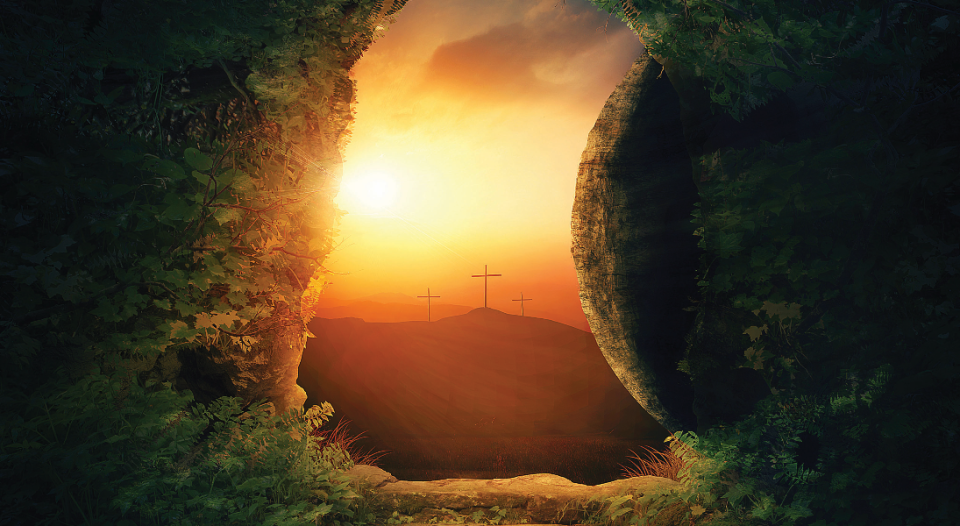I’d always skimmed over the earthquake in Matthew’s resurrection story (28:1-10) until I was in “a big one.” I live in Alaska. There hadn’t been “a big one” in my part of the state since Good Friday 1964, when a 9.2 shaker on the Richter scale destroyed homes, killed dozens and forced the relocation of Southcentral Alaska coastal towns decimated by tidal waves.
Scientists warned there would eventually be another big one here. I was making breakfast for my children in 2018 when it hit—a 7.1 quake. I was downstairs with the 2-year-old when the shaking started. I knew I was supposed to shelter in place—stop moving!—but my 5-year-old was somewhere upstairs alone, and he started screaming. I was filled with terror. Bookshelves flung their contents; photos sailed off the mantle. The shaking was the hardest I’d ever felt, and it just kept going.
I grabbed my toddler and tried to run upstairs, but the shaking made it difficult to walk. A massive chandelier was swinging wildly above my head, and I saw the folly in climbing the stairs under it while holding a toddler. Glass shattered upstairs. My 5-year-old was still screaming. Was he hurt? I was screaming. We were all afraid.
After less than a minute of shaking, which felt like an hour, everything was still. I went upstairs and stopped short: a sea of broken glass filled the hall and bathroom floor. A wall-mounted bathroom mirror had shattered and sent shards throughout the hall, nearly into my son’s bedroom. My son, who I thought might have been in the bathroom, was safe on his bedroom floor. I felt a moment of joy amid the terror.
Mary Magdalene and the other Mary who walked to the tomb went there expecting death. They were already traumatized by the terror of seeing their beloved Jesus beaten and executed. Then the earth began to quake, and they were afraid all over again.
I was filled with terror. Bookshelves flung their contents; photos sailed off the mantle. The shaking was the hardest I’d ever felt, and it just kept going.
Instead of broken glass, they saw blinding light and an angel, who shone with painful brightness. Do not be afraid, the angel said, he has been raised. The women were still filled with terror but something else crept in—great joy. They ran to tell the disciples and met the risen Lord on the way.
The Easter story is one of interwoven fear and joy—the same is true in our lives. We don’t have to live on a fault line to feel the ground move beneath our feet. We have all felt the earth quake, so to speak. It’s the phone call that begins with “sit down.” It’s the doctor with bad news from the PET scan. It’s the realization that you can’t fix the relationship. It’s the realization that you can’t fix your child. It’s another month when the money runs out before the month does. We have all lived through some kind of earth-quaking experience. We have all felt fear.
Yet sometimes it is precisely in the shaking that we get a glimpse of great joy. Someone you love is holding your hand. A member of your church brings a hot meal. A Scripture verse brings a word of comfort. God’s peace comes unexpectedly. Someone offers you forgiveness. Someone sits quietly beside you.
The women at the tomb didn’t suddenly drop their fears when they learned that Jesus was alive. The women ran to tell the good news while they were full of fear and joy. The same may be true for us. They were afraid, but they went anyway. They didn’t go alone—they had each other—and as they went, they found Jesus. I can think of worse metaphors for the life of a disciple.
The Easter story is one of interwoven fear and joy—the same is true in our lives.
Right after the quake of 2018, my children and I were together on the floor of my older son’s room when the first big aftershock came, a 5.7. Aftershocks always come after a big quake, and you can’t predict them. The aftershock was another big jolt, but this time it was different. We sat with our arms around each other and a few stuffed animals thrown in for good measure. We were afraid but thankful to be together.
“No storm can shake my inmost calm” read the words of the hymn “My Life Flows On in Endless Song” (Evangelical Lutheran Worship, 763). This is not entirely true when I’m relying on a calm I must manufacture. I can’t manufacture it. But God can. Our inner calm is God’s own peace, given by the Spirit.
What I know from Christ’s death and resurrection is that God doesn’t promise a life of steady ground. God promises God’s presence in the shaking and the joy of God’s loving embrace.
God says to us what Jesus said to those fearful and joyful women at the tomb: you will see me. It’s a solid foundation on which to rest.






